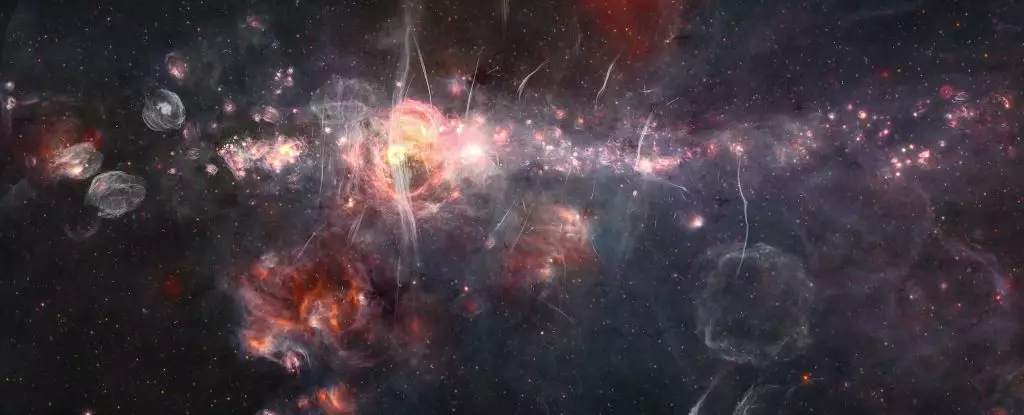The supermassive black hole named Sagittarius A* (Sgr A*) at the center of our Milky Way galaxy may not be as active as some other galaxies, but it is still a fascinating object to study. Recently, astrophysicists Gustavo Magallanes-Guijón and Sergio Mendoza of the National Autonomous University of Mexico made an intriguing discovery – Sgr A* seems to be pulsing. Every 76 minutes, the gamma-ray flux emitted by the black hole fluctuates, suggesting an orbital motion of something whirling around it. This finding, awaiting peer review, has the potential to deepen our understanding of black holes and their surroundings.
While black holes themselves do not emit any detectable radiation, the space around them is a different story. In the extreme gravitational regime outside a black hole’s event horizon, a variety of phenomena can occur. From the region of Sgr A*, light is emitted in different wavelengths, with varying levels of intensity over time. Researchers have previously observed periodic fluctuations in the radio and X-ray emissions from the black hole, and now there is evidence of a similar pattern in gamma-ray emissions.
A New Perspective on Gamma-ray Emissions
Gamma radiation was only confidently linked to Sgr A* in 2021, leading Magallanes-Guijón and Mendoza to investigate potential secrets in the gamma-ray data. They analyzed publicly available data from the Fermi Gamma-ray Space Telescope recorded between June and December 2022, looking for periodic patterns. Their efforts paid off; they discovered that Sgr A* emits a flare of gamma radiation every 76.32 minutes. Gamma radiation represents the most energetic range of light in the Universe.
The researchers found that the periodicity of the gamma-ray flare closely matches that of the radio flare originating from Sgr A*. Additionally, the X-ray flare has a periodicity twice that of the radio and gamma-ray flares. This correlation suggests an underlying common cause for these emissions. While black holes themselves do not emit radiation, regularly occurring periodicity often indicates orbital motion, implying the presence of an object orbiting the black hole.
A Bloomy Explanation
According to a 2022 study, the most probable object responsible for the periodic emissions is a blob of hot gas held together by a powerful magnetic field, which causes particle synchrotron acceleration and radiation emission. This gas blob orbits Sgr A* at a distance similar to the orbit of Mercury around the Sun. However, with an orbital period of 70 to 80 minutes, it travels at incredibly high speeds, approximately 30 percent of the speed of light. The radio data supports the interpretation of this gas blob emitting across multiple wavelengths.
The Significance of Gamma-ray Flares
The discovery of gamma-ray flares further supports the gas blob theory. As the blob orbits, it emits energetic flares, and as it cools down, it glows more intensely in radio light. This model explains the recurring periodicity observed in the emissions from Sgr A*. However, there are still details to be understood. Black holes are notoriously challenging to study, and Sgr A* is no exception. Further observations across multiple wavelengths would provide valuable insights into the enigmatic nature of our galaxy’s core.
Unveiling the Dark and Mysterious Heart
Despite the progress made in understanding the behavior of the supermassive black hole at the center of our Milky Way, there is much more to learn. The study of black holes remains an ongoing endeavor, and continued observations can contribute to unraveling the mysteries of these cosmic phenomena. By peering into the depths of the Universe, scientists will continue to shed light on the dark and mysterious heart of our galaxy.
The recent discovery of pulsing gamma-ray emissions from Sgr A* adds a new dimension to our understanding of supermassive black holes. As researchers delve deeper into the data and investigate further, they hope to gain more insight into the underlying mechanisms driving these fascinating phenomena. The study of black holes promises to reveal more secrets about the nature of our Universe and the intricate dance of celestial objects within it.



Leave a Reply